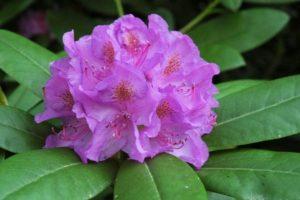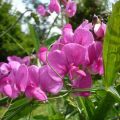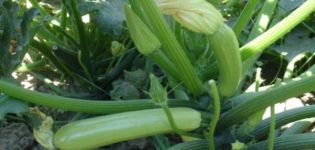Description of the 23 best varieties and types of Muscari plants, planting and care in the open field
Muscari flowers bear a surprising resemblance and hyacinth. Therefore, gardeners and florists call it mouse hyacinth. Muscari is the first to wake up and bloom after the winter frosts. The plant got its name due to its delicate musky aroma, which comes from numerous flowers in the form of bells. The features of caring for a Muscari flower are quite simple, it easily tolerates frost, which allows flower growers to plant in open ground in late autumn.
Description and features
In its natural environment, the plant is found in forests and on the mountain slopes of the Crimean Peninsula, the Caucasus, the Mediterranean countries, Asia, Africa and Europe. Muscari belongs to the bulbous plants of the asparagus family. Previously, the flower was ranked among the varieties of hyacinths.
Muscari characteristics and features:
- The maximum flower height is 30-35cm.
- Leaves are narrow, long, green, re-grow in autumn.
- The flower stalk is tall in the form of a bunch of grapes, with many small bell flowers of purple, blue, white and light blue shades.
- The flower is resistant to sudden changes in temperature and frost.
- After the spring flowering period, the plant withers completely.
- Due to its early flowering, the plant is rarely exposed to diseases and pests.
Important! For the bulbs and flowers of Muscari, birds do not pose a danger, because the plant contains substances that are poisonous for birds.
Kinds
Today more than 60 species of Muscari are known. But flower growers and gardeners prefer plants with resistant characteristics to temperature extremes and frost.

Armenian
Muscari "Armenicum" is distinguished by its unpretentiousness to climatic conditions. The active flowering period begins in late spring and lasts about 3 weeks. The inflorescences of "Armeniacum" are dense. Blue bells with a white border at the bottom of the inflorescence smoothly transition to the lighter flowers at the top of the plant.
Grozny
The vine-shaped Muscari has been used in decorative floriculture since the late 16th century. This type of plant has gained great popularity among gardeners, although its flowers are smaller than those of other varieties of this culture. But the color scale of the muscari grape variety is larger. In nature, there are blue, light blue, white and pink varieties of flowers.
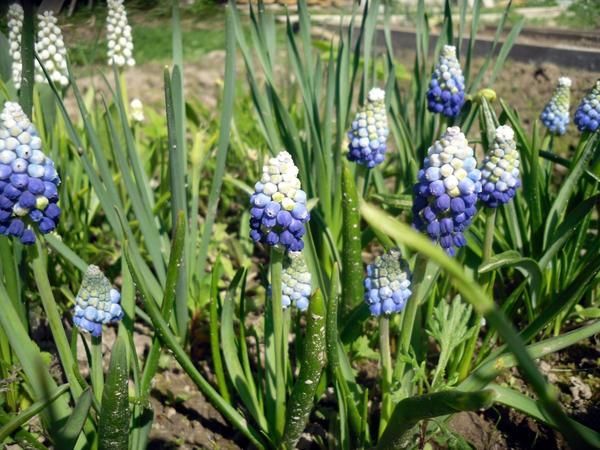
Broadleaf
The species is distinguished by wide leaf plates that look more like tulip leaves. On the peduncle, a dense inflorescence is formed with bells of dark blue flowers. Several sprouts emerge from each of the planted bulbs of this variety.
Pale
The short plant is most often found in the mountains. Inflorescences are small, but dense, white, blue, sometimes pink.
Crested
When the crested Muscari blooms, a crest forms in the upper part of the peduncle. Therefore, the plant has two tiers, purple bells on the peduncle itself and small purple flowers on the crest.

Osh
A beautiful garden pet "Osh" comes from Iran. The active flowering phase occurs in mid-spring. The inflorescences are dense, of various blue shades, occasionally there are lighter flowers, leaves of an unusual crescent shape. The flower quickly dies from an excess of moisture.
Pretty
It is the earliest Muscari species from the Mediterranean countries and enters the active flowering phase at the end of winter. A short plant with dense inflorescences of dark blue color.
Long-flowered
Muscari of this species is found on the slopes of the Transcaucasus and the Alpine mountain belt. The maximum height of the peduncle is 15 cm. During the flowering period, it is covered with blue bell-shaped flowers. Each inflorescence has up to 50 small flowers.
Belozevny
White-green Muscari will grow up to 20 cm. The inflorescences are dense, with dark purple flowers that have white teeth at the edges.
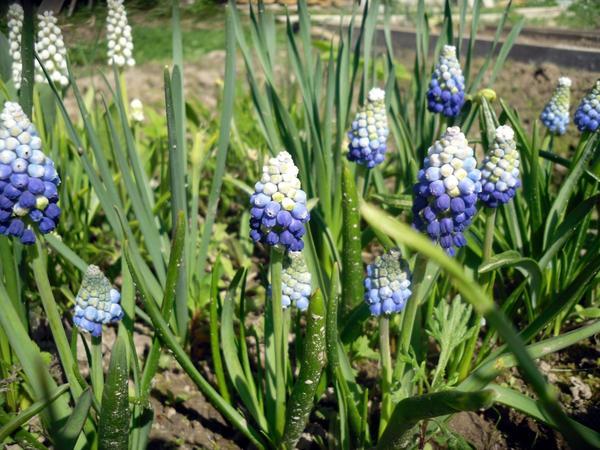
Large-fruited
In its natural environment, the plant is found in Greece and Turkey. Flower height up to 25 cm. The active flowering phase begins in May. Inflorescences are yellow, with a brown frame. The variety is thermophilic, does not tolerate frost.
Racemose
The racemose form of Muscari will grow up to 12 cm. The inflorescences are dense with blue bells. The active flowering period occurs in late spring and lasts 3-4 weeks.
Azure
In its natural environment, the "Azure" species meets on the mountain slopes in Turkey. The plant tolerates temperature changes well, but does not like excessive moisture. Enters the flowering phase in April. The inflorescences are dense, blue and blue shades.
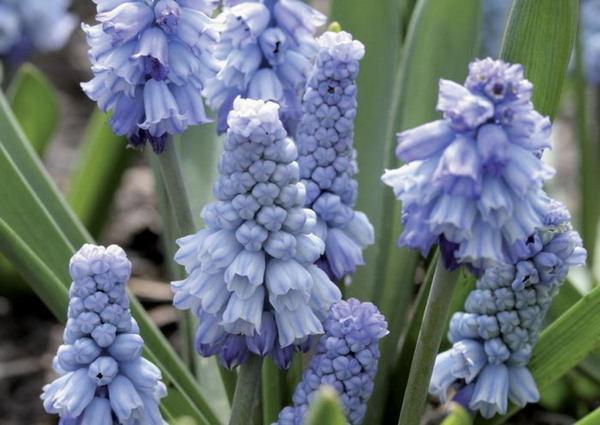
Important! Each type of plant is subdivided into varieties that differ in size, leaves and inflorescences, as well as colors.
Popular varieties
Each variety of flowers has different flowering times and decorative properties. Therefore, the competent planting of Muscari in open ground will allow you to enjoy the beautiful views and pleasant aromas of flowering plants for a long time.
Blue spike
A flower up to 25 cm high, enters the flowering phase in late spring. Inflorescences are terry, branched, with multiple blue bells. Up to 170 flowers are placed on one inflorescence.
Cantab
Perennial Muscari variety. The active flowering phase begins in May. The inflorescences are dense, with blue-blue flowers.

Christmas pearl
The variety "Christmas Pearl" is distinguished by beautiful, large inflorescences of purple hues.
Flight of fantasy
Unusual Muscari variety with greenish and blue flowers.
Dark eyes
The variety grows up to 25 cm, the leaves are narrow, dark green in color. The flowering period is late spring. Inflorescences are dense, blue shades, white border on the tips of the bells.
Plumosum
Variety "Komosum Plumozum" refers to the crested Muscari species. The flower is distinguished by its decorative, shaggy appearance and pleasant aroma.

Sky blue
Perennial Muscari variety.The inflorescences are dense, bell-shaped flowers are blue, with a light pleasant aroma.
Sapphire
Frost-resistant variety. Active flowering begins in April. Inflorescences are dense, with small blue bells with a silvery shade.
Alba
White inflorescences of "Alba" variety will decorate flower beds and spring garden compositions. It enters the active flowering phase in March.
Big smile
The variety is distinguished by large inflorescences up to 12 cm in light blue shades with a white frame around the edges. It begins to bloom in mid-spring. Flowering period 2-3 weeks.
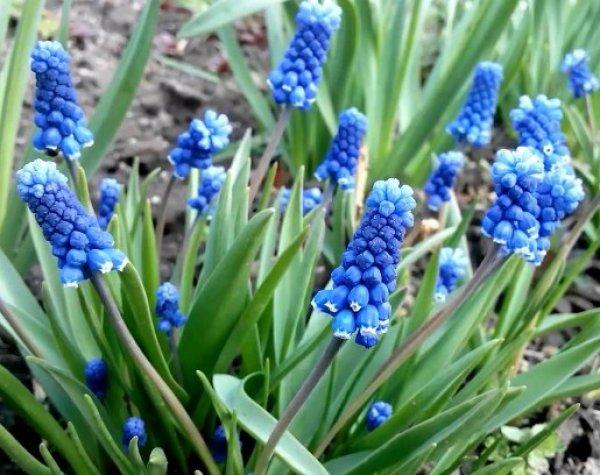
Razletayka
Muscari varieties "Album" are suitable for decorating alpine garden landscapes and flower beds. The plant blooms in mid-spring. Inflorescences are dense, white.
Growing in the garden
Muscari is an unpretentious plant and does not require special care. The flower grows in its natural environment in difficult conditions of mountain slopes and forests. Therefore, the plant is undemanding to the composition of the soil and grows even in the most infertile areas.
When to plant
The bulbous culture is planted in open ground in the fall. But if autumn works are missed, then flowers can be planted in early spring.
Before planting the plant, the soil is thoroughly loosened to a depth of 8 to 10 cm.
How to plant
Before planting the bulbs in open ground, they are examined. There should be no obvious damage or signs of rotting on the seed. Next, the bulbs are poured with a manganese solution or other disinfecting agents and left for 30-40 minutes. Planting holes are prepared in advance and watered. The depth of the holes is 7-10 cm. The larger the bulbs, the more they should be deepened. Small onions deepen by no more than 3 cm.
A distance of 5 to 10 cm is maintained between the holes.
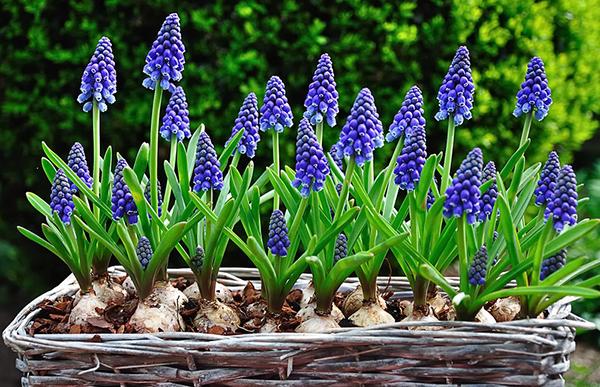
Important! It is in large groups that Muscari give the best decorative result.
Care features
To obtain large flowers with bright inflorescences, lime is added to the soil with a high acid content. The plant will develop on acidic soil, but the decorative properties will be lost. The plant does not tolerate waterlogging of the soil, so it is planted away from ground and soil waters.
Watering
Active growth begins in early spring, when the soil is well moistened after winter precipitation and rains. And since the flower does not like an excess of moisture, it does not need systematic irrigation. Water the plant only if necessary. If there is no precipitation during the active phase of flowering, then the plant needs additional soil moisture.

Top dressing
If the soil lacks nutrients and nutrients, the plant is fed with organic fertilizers. In the fall, the soil is mixed with humus.
Bloom
The flowering time of Muscari differs from its variety and varieties. Some plant varieties bloom at the end of February, there are species that enter the flowering phase only in June.
Transfer
A spring flower is transplanted every 5 years. On well-groomed and fertile soil, the plant can not be touched for up to 10 years, but then you still have to transplant. Muscari tolerate a change of place well, therefore, for decorative purposes, sprouts that have already grown from the bulbs can be transplanted.
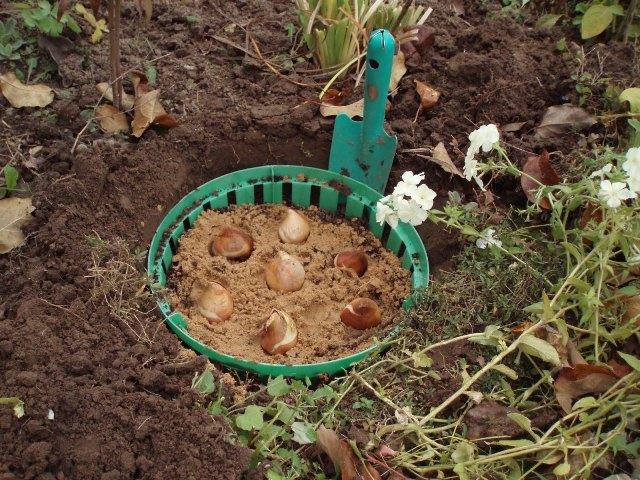
Distillation
Each crop variety has its own flowering period. Therefore, for forcing plants, bulbs of the same varieties are selected.
Reproduction
Even a novice gardener or florist can cope with the reproduction of spring flowers in a personal plot.
Vegetative way
During the season, up to 30 babies are formed at the mother's bulb, which are carefully separated and seated.
Self seeding
Muscari has the ability to reproduce independently. After flowering, seed pods are formed, which open and the seeds fall into the ground.To control the number of Muscari livestock, only a few copies of the plants are left and after the seeds ripen, they are collected.
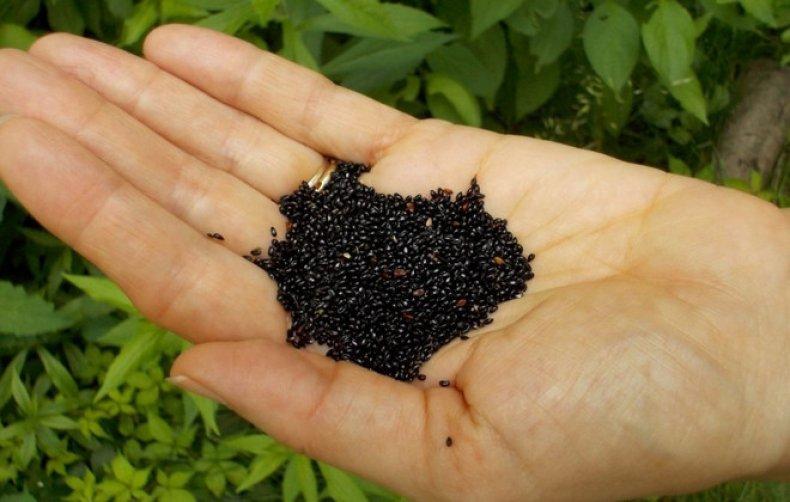
Diseases and pests
Most varieties of this plant, due to the early flowering period, are not susceptible to diseases and pests. But there are times when troubles happen with spring primroses.
Mosaic
The main cause of the disease is an infected flower bulb. With a disease of green or cucumber mosaic, peculiar patterns appear on the leaves, and they themselves are deformed.
Aphid
Poor-quality planting material may be infected with aphid larvae that are in the bulbs of plants. In this case, the plant must be dug up and destroyed to avoid further contamination of neighboring flowers.
Spider mite
Muscari is rarely affected by spider mites. But if such a case occurs, then the plant requires urgent inspection and processing. For the prevention of diseases and pests, plants are sprayed with soapy water or special preparations.
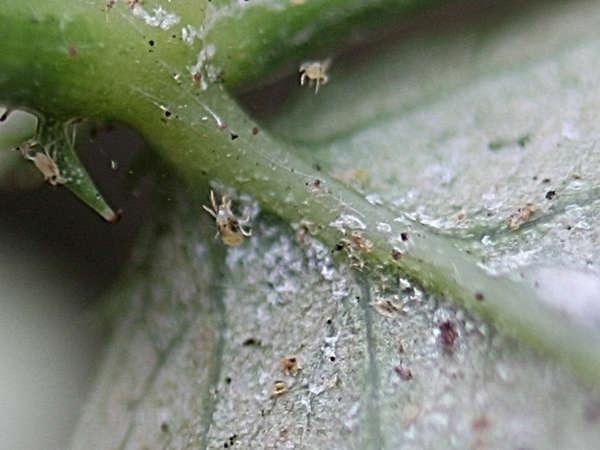
After flowering
After the end of the active flowering period, the plants also require some care.
Preparation for wintering
The flower-bearing stems are carefully removed, after which the flower is fed with fertilizers containing phosphorus or potassium.
Watering
While the leaves of Muscari are green, the plant is watered. And as soon as they begin to turn yellow and dry, irrigation work stops.
Transfer
It is required to repot the spring primrose every 5 years, and more often if necessary. If the flower does not develop at the place of its current growth and does not bloom well, then it is time to find a new place for it in the garden. The new bulbs that have appeared are carefully separated from the mother plant and transplanted as an independent flower.

Mulching
If the plants have recently been planted in open ground, then in the autumn period peat is necessarily added to the soil and the soil is mulched.
Storing the bulbs
In the northern regions, for the winter period, flower bulbs are dug out of the ground and sent to storage:
- The bulb is ready for wintering outside the ground if all the leaves are yellow and dry.
- All planting material is carefully dried in natural conditions.
- Place the bulbs in a container with peat or pre-moistened sand.
- Planting material is stored in comfortable conditions at temperatures from +15 to 17 degrees.
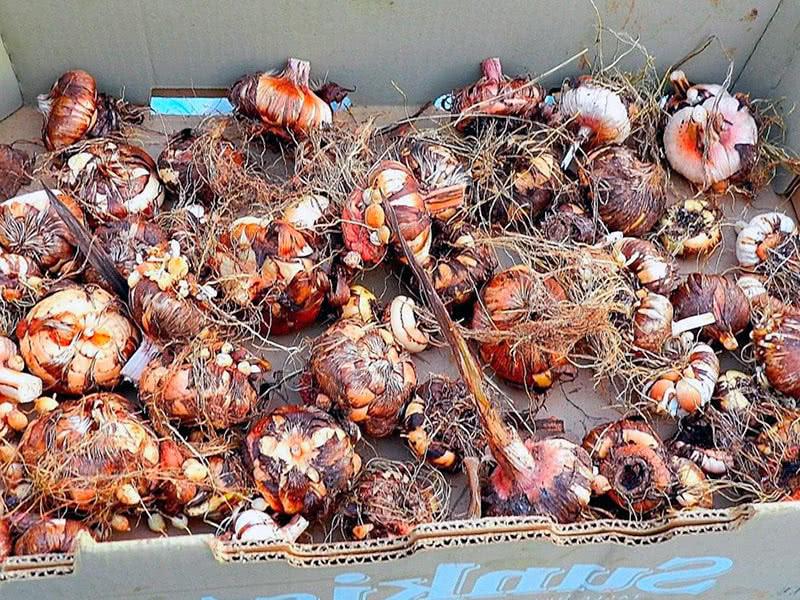
Important! During storage of the bulbs, the moisture content of the peat or sand must be controlled.
Mouse hyacinth at home
Growing mouse hyacinth indoors is not difficult. It is necessary to select the largest bulbs and keep them at a temperature of +9 degrees for 2-3 months. Then plant in a pot and follow the elementary rules of watering and temperature conditions. In this case, the plant will decorate the home with its primroses.
Answers on questions
Why doesn't it bloom?
If the plant stops blooming, this is the first sign that it is time to replant or separate the bulbs.
What to do if sprouted in autumn?
Some Muscare varieties develop and germinate quickly when planted in autumn. For flowers, this does not threaten death, they calmly overwinter with leaves, and in spring they will actively begin their growth.
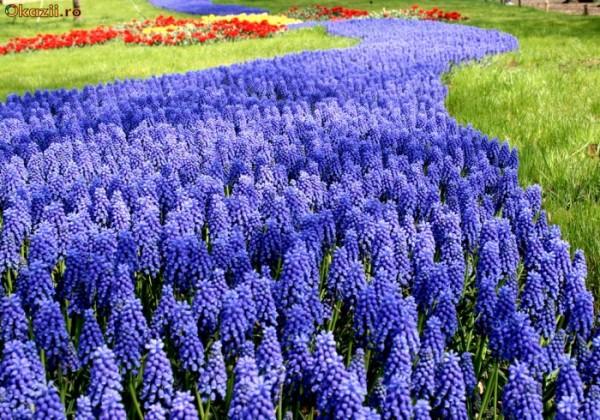
Application
Muscari contains many useful substances that have found their application in medicine and cosmetology.
ethnoscience
Infusions from the plant are used as antiseptic and anti-inflammatory agents, help with severe stress and neuroses.
The essential oil of the flower helps with diseases of the bronchial system.
Cosmetology
The high content of essential oils in the plant allows its use in cosmetology. Creams, tonics and balms are made from extracts of plants.
Landscape design
Landscape designers and florists love Muscari flowers for their high decorative properties. In combination with other early cultures, beautiful spring compositions, alpine slides and rocky gardens are created.

Reviews
Elena Nikolaevna, Moscow region
We planted several varieties at Muscari's dacha last year. Completely unpretentious and hardy flowers. They bloomed for a very long time. One variety faded, and the other bloomed immediately. The beauty was enjoyed all spring and half of the summer.
Irina Grigorievna, Samara
For three years now, my spring has begun with the appearance of the Mouse Hyacinth. The flowers, although small, are very beautiful and fragrant, and care for them is not needed at all. I will also buy other varieties of these flowers.
Inna Petrovna, Petrozavodsk
We planted Muscari in the garden, we thought they would not take root, our land is very bad. All the bulbs grew and bloomed for a long time with beautiful blue and purple flowers. So I'm thinking, to dig them up for the winter, or can I leave them in the ground?
